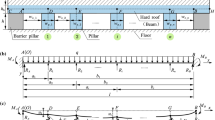Summary.
Based on cusp-type catastrophe theory, a sample rock–rock model for studying the pillar rockburst mechanism is presented in this paper. It is shown that the stiffness ratio, K, of the roof and floor to the pillar plays an important role in the outbreak of instability. Additionally, simple formulae for the deformation jump and the energy release are derived. Based on the assumption that there exists a proportional relationship between the number of microseismic events and microfractured elements, the theoretical microseismic event rate produced by the double rock sample, loaded in series under uniaxial compression, is obtained. Using a newly developed numerical code, RFPA2D, the progressive failure process and associated microseismic behavior of the twin rock samples are simulated, which shows that the spatial distribution of microseismic events develops progressively from disorder at the initial loading stage to order prior to the main shock. The numerically simulated results also confirm that a soft roof and floor promote an unstable failure or collapse of pillars, while a stiff roof and floor can lead to a stable failure of pillars. Additionally, the simulated results reproduce the deformation jump and the energy release that occur during a pillar rockburst. It is demonstrated that the proposed model properly simulates the pillar failure process.
Similar content being viewed by others
References
N. G. W. Cook (1976) ArticleTitleSeismicity associated with mining Eng. Geol. 1 99–122 Occurrence Handle10.1016/0013-7952(76)90015-6
J. Cubiu B. Shaw (1976) ArticleTitleThe geological implications of steady-state mechanisms in Catastrophe Theory Math. Geol. 8 657–661 Occurrence Handle10.1007/BF01031096
Gill, D. E., Abortion, M., Simon, R. A. (1993): Practical engineering approach to the evaluation of rockburst potential. In: Young, R. P. (ed.), Rockbursts and seismicity in mines. pp. 63–68.
S. Henley (1976) ArticleTitleCatastrophe Theory Model in geology Math. Geol. 8 649–655 Occurrence Handle10.1007/BF01031095
Hudson, J. A., Fairhurst C. (1969): Tensile strength, Weibull’s theory and a general statistical approach to rock failure. In: Proc., Civil Engineering Materials Conference, Southampton, pp. 901–904.
J. C. Jaeger N. G. W. Cook (1969) Fundamentals of Rock Mechanics Methuen London
D. Krajcinovic D. Sumarac (1989) ArticleTitleA mesomechanic model for brittle deformation processes, Part I J. Appl. Mech. 56 51–62 Occurrence Handle10.1115/1.3176065
D. Krajicinovic M. A. G. Silva (1982) ArticleTitleStatistical aspects of the continuous damage theory Int. J. Solids Struct. 18 551–562 Occurrence Handle10.1016/0020-7683(82)90039-7
Lockner, D. A., Madden, T. R. (1991): A multiple-crack model of brittle fracture. J. Geophys. Res. 96(19), 623–19, 642.
Lockner, D. A., Moore, D. E., Reches, Z. E. (1992): Microcrack interaction leading to shear fracture. In: Tillerson, J. R., Wawersik, W. R. (eds) Proc., 33rd Symposium on Rock mechanics, Balkema, Rotterdam, pp. 807–815.
C. D. Martin N. A. Chandler (1994) ArticleTitleThe progressive fracture of Lac du Bonnet granite Int. J. Rock Mech. Min. Sci. 31 IssueID6 643–659 Occurrence Handle10.1016/0148-9062(94)90005-1
J. R. Rice (1983) ArticleTitleConstitutive relation for fault slip and earthquake instability Pageoph 121 443–475
Salamon, M. D. G. (1993): Some application of geomechanical modeling in rockburst and related research. In: Young, R. P. (ed.), Rockbursts and seismicity in mines. 297–309.
P. T. Saunders (1980) An introduction to Catastrophe Theory Cambridge University Press Cambridge
C. A. Tang (1993) Catastrophe in rock unstable failure (in Chinese) China Coal Industry Publishing House Beijing 26–27
C. A. Tang (1997) ArticleTitleNumerical simulation of progressive rock failure and associated seismicity Int. J. Rock Mech. Min. Sci. 34 249–262 Occurrence Handle10.1016/S0148-9062(96)00039-3
C. A Tang J. A. Hudson X. H. Xu (1993) Rock failure instability and related aspects of earthquake mechanisms China Coal Industry Beijing
C. A. Tang Z. H. Chen X. H. Xu C. Li (1997) ArticleTitleA theoretical model of the Kaiser effect in rock Pure Appl. Geophys. 150 203–215 Occurrence Handle10.1007/s000240050073
Weibull, W. (1951): A statistical distribution function of wide applicability. J. Appl. Mech. 293–297.
Y.-Q. Yin G.-T. Zheng (1988) ArticleTitleA cusp-type catastrophic model of fault earthquakes Acta Geophys. Sin. 31 IssueID6 657–663
M. H. Yu (1998) Double twin strength criterion and its application Science Press Beijing
Author information
Authors and Affiliations
Rights and permissions
About this article
Cite this article
Wang, S., Lam, K., Au, S. et al. Analytical and Numerical Study on the Pillar Rockbursts Mechanism. Rock Mech. Rock Engng. 39, 445–467 (2006). https://doi.org/10.1007/s00603-005-0075-2
Received:
Accepted:
Published:
Issue Date:
DOI: https://doi.org/10.1007/s00603-005-0075-2




